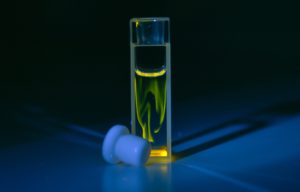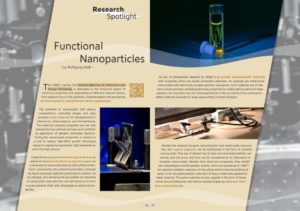Functional Nanoparticles
The i-MEET, namely the Institute Materials for Electronics and Energy Technology, is dedicated to the functional aspect of electronic properties and applicability of different material classes. One research focus is the synthesis, characterization and processing of nanocrystals for optoelectronic device applications.
The synthesis of nanocrystals with various compositions, controlled shapes and sizes provides novel materials for developments in electronics, photocatalysis, and biointerfacing. The material’s physical properties are not only tailored during synthesis but also post synthetic by application of galvanic exchange reactions. Tuning the nanocrystals properties in solution is a tool to replace high-effort growth techniques based on expensive equipment, high temperature, and ultra-high vacuum.
A special focus is put on infrared-optical devices as well as on detectors for the X-ray spectral region. As a necessity for nanocrystal devices with sufficient electronic conductivity, the surface functionality is tailored by ligand exchange methods, performed in solution. As an example, zero-dimensional perovskites are attached to nanocrystal cores with the rock-salt structure to form a quasi-epitaxial shell, with advantageous electrical properties.
 An aim of nanoparticle research at i-Meet is to provide nanocomposite materials with properties which are hardly achievable otherwise. An example are metal-oxide nanocrystals with electrically tunable plasmon resonances. Such materials are of interest in smart windows, exhibiting dimming properties for visible light as well as for heat radiation. An important topic for these applications is the up-scaling of the synthesis to obtain sufficient amounts for large area printing of smart windows.
An aim of nanoparticle research at i-Meet is to provide nanocomposite materials with properties which are hardly achievable otherwise. An example are metal-oxide nanocrystals with electrically tunable plasmon resonances. Such materials are of interest in smart windows, exhibiting dimming properties for visible light as well as for heat radiation. An important topic for these applications is the up-scaling of the synthesis to obtain sufficient amounts for large area printing of smart windows.
Besides the classical inorganic semiconductor and metal-oxide nanocrystals, also organic pigments can be synthesized in the form of colloidal nanocrystals. They are of interest due to their environmental stability, low toxicity, and low price, and thus can be considered as an alternative to inorganic nanocrystals. Besides their electronic properties, they exhibit also advantageous photocatalytic activity, which are pioneered in i-MEET for selective oxidation reactions, for the photo-electrochemical splitting of water, or for the photocatalytic reduction of heavy metal salts applied for water cleaning. The same materials are also applied in the form of hierarchical nano-architectures with nature inspired shapes as electronic interfaces to bio-materials.

Text by Wolfgang Heiß, images by Max Gmelch
